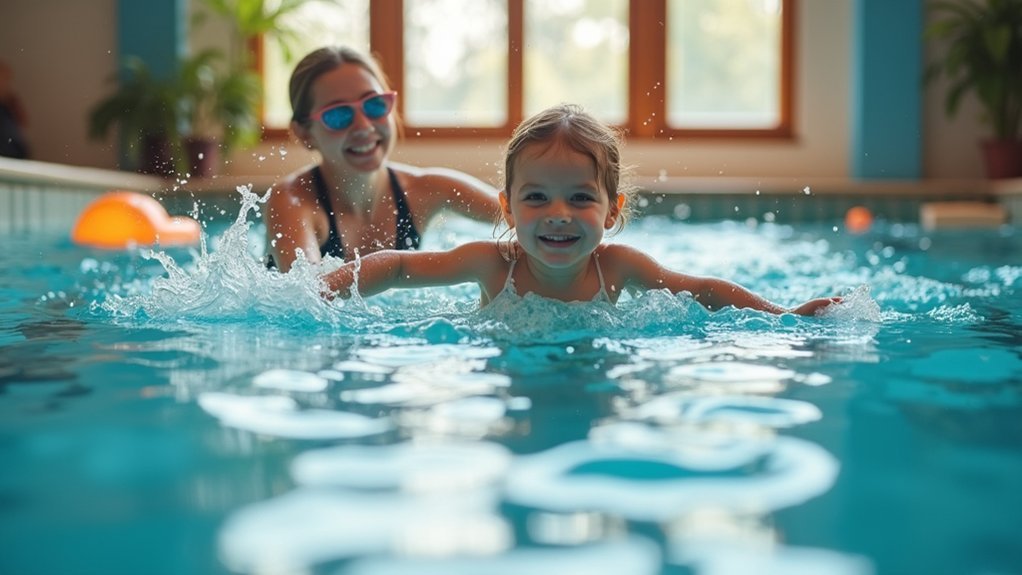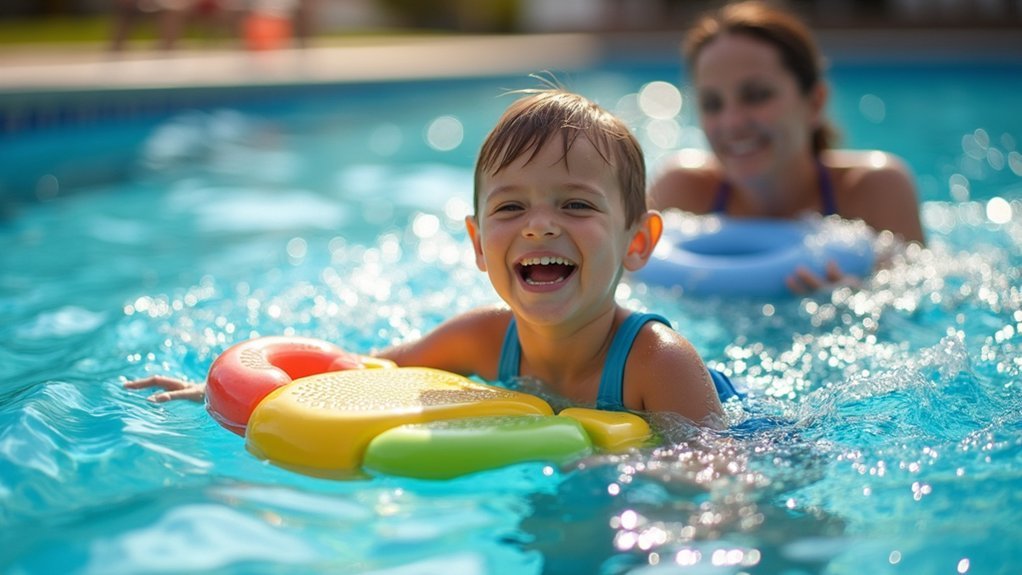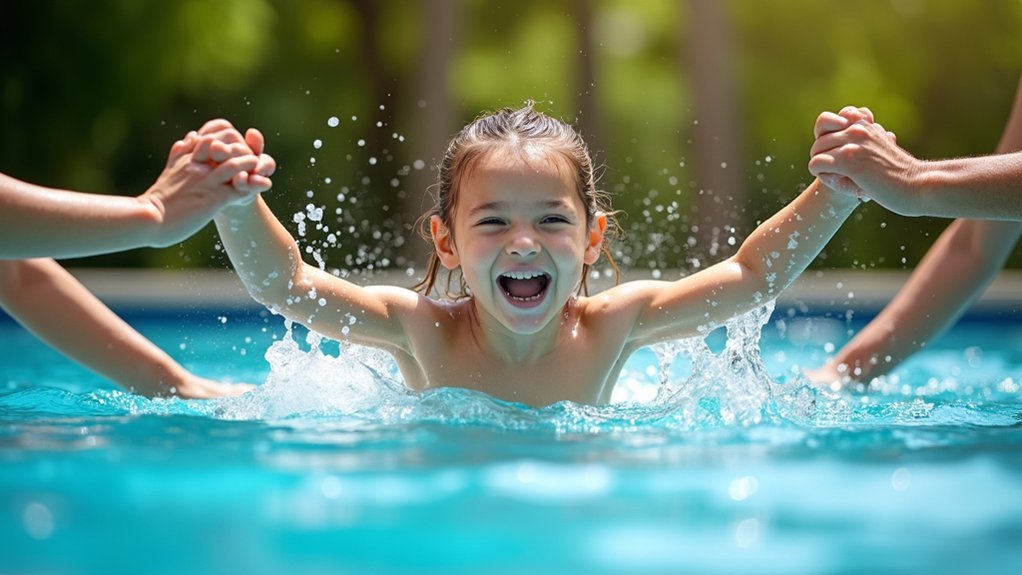Aquatics provides ideal therapy for cerebral palsy through water’s buoyancy, which reduces joint stress while allowing freedom of movement. You’ll benefit from muscle relaxation in warm water, pain reduction from hydrostatic pressure, and the ability to build strength without straining joints. Water’s resistance improves coordination while creating an equal playing field for social interactions. With adaptive equipment, you can maximize therapeutic benefits regardless of mobility limitations. Discover how this supportive environment transforms both physical capabilities and confidence.
The Buoyancy Advantage: How Water Supports Movement Freedom

When individuals with cerebral palsy enter water, they experience an immediate sense of freedom as buoyancy counteracts the constant pull of gravity. This weightless environment transforms mobility possibilities, making movements that are difficult on land suddenly achievable.
You’ll notice how water’s natural properties support the body, reducing stress on joints while enabling improved range of motion. Exercises become more manageable as the buoyant force assists in maintaining posture and balance.
The water’s embrace provides confidence by eliminating the fear of falling. With reduced gravitational constraints, you’re able to work on strengthening muscles and improving coordination in a supportive medium. The warm water temperature helps relax tight muscles and significantly reduces pain from stiffness, making movement more comfortable.
In water’s gentle hold, fear dissolves as bodies find freedom to build strength beyond gravity’s limiting grasp.
This therapeutic advantage creates opportunities for developing motor skills that can eventually translate to enhanced function on dry land.
Muscle Relaxation and Pain Reduction in Warm Water
Warm water therapy offers remarkable relief for your child’s spastic muscles associated with cerebral palsy.
The heat naturally loosens tight muscle groups while increasing elasticity in soft tissues, allowing for greater comfort during movement and exercise.
You’ll notice your child experiences reduced pain as the therapeutic temperature stimulates improved circulation and triggers the release of endorphins, nature’s own pain relievers. The water’s buoyancy significantly reduces gravitational stress on joints and muscles, creating an ideal environment for gentle yet effective therapeutic exercises.
SUBHEADING DISCUSSION POINTS
The therapeutic properties of warm water provide significant benefits for individuals with cerebral palsy, particularly in muscle relaxation and pain reduction. When you or your child enters warm water, the heat immediately increases soft tissue elasticity, allowing muscles to relax and spasticity to decrease. This creates an environment where movement becomes easier and less painful.
- Warm water enhances muscle elasticity, reducing resistance during stretching exercises.
- Hydrostatic pressure applies gentle, consistent force that improves circulation and reduces swelling.
- The buoyant environment decreases joint stress, alleviating pain during movement.
- Enhanced proprioception (body awareness) in water helps improve movement control.
- Breathing exercises and aquatic yoga in warm water offer additional relaxation benefits beyond physical therapy.
Water’s natural buoyancy reduces body weight by approximately 90 percent, creating an ideal environment for non-ambulatory children to experience movement freedom.
In this soothing environment, therapy sessions can last longer and achieve better results than land-based alternatives.
Soothing Spastic Muscles
Spastic muscles present one of the most challenging aspects of cerebral palsy, often causing persistent discomfort and limiting mobility. In warm water, you’ll experience immediate relief as buoyancy reduces gravitational stress on your tense muscles and painful joints.
The unique combination of hydrostatic pressure and warmth works wonders for spasticity. The consistent pressure improves your circulation while warm temperatures increase muscle elasticity, considerably reducing spasms.
You’ll notice enhanced joint mobility as your muscles relax in this therapeutic environment. Water’s natural resistance allows for gentle strengthening without overexertion, while its viscosity supports controlled stretching with minimal injury risk. This hydrostatic pressure on the body helps decrease swelling while promoting better blood flow throughout your system.
These properties create an ideal setting for pain-free movement and effective muscle relaxation techniques—transforming strenuous exercises into soothing therapy that improves both physical function and emotional well-being.
Natural Pain Relief
When you immerse yourself in warm water, a natural analgesic effect takes hold, providing relief that medication alone often can’t match. The hydrostatic pressure gently compresses your body, reducing muscle stiffness while the warmth creates a calming environment that promotes relaxation. For cerebral palsy patients, this whole-body pressure significantly alleviates joint and muscle pain that often accompanies the condition.
- Your muscles tension diminishes as the buoyancy supports your weight, letting tight muscles finally release.
- Endorphins—your body’s natural painkillers—are released during water exercises, enhancing comfort.
- Blood circulation improves, delivering oxygen and nutrients to sore muscles.
- The warm water acts as heat therapy, reducing inflammation and stiffness.
- You’ll experience greater mobility as pain decreases, allowing movements that might be too uncomfortable on land.
Building Strength Without Joint Stress
Although traditional exercise can be challenging for individuals with cerebral palsy, aquatic environments offer a revolutionary approach to strength building.
Water’s natural buoyancy reduces gravity’s impact on your joints while its viscosity provides resistance that builds muscle without excessive strain.
Water creates a gentle sanctuary where resistance builds strength while your body feels weightless and protected.
You’ll find that leg lifts, arm movements, and water walking effectively strengthen muscles while the hydrostatic pressure improves circulation to working tissues.
Pool-based resistance training using noodles and bands can add challenge as you progress.
The beauty of aquatic therapy is how it transforms strength training into an enjoyable experience.
You can build muscle through activities like throwing balls, kicking exercises, and pool edge movements that feel more like play than therapy.
This engaging environment increases your motivation while the warmth relaxes muscles, reducing spasticity common in cerebral palsy.
Enhanced Coordination and Balance Through Aquatic Resistance

Individuals with cerebral palsy often face significant coordination challenges on land, but water provides a unique environment where balance training becomes both accessible and effective. The combination of buoyancy and resistance creates ideal conditions for improving coordination without straining joints.
During aquatic therapy, you’ll experience:
- Water resistance that challenges your muscles from all directions, enhancing bilateral coordination
- Reduced impact on joints while your body works against gentle, consistent resistance
- Transformation training that varies intensity and exercise types to improve full-body coordination
- Exercises that help restore muscle tension imbalances, particularly beneficial for ataxic cerebral palsy
- Progressive improvement in balance abilities that transfer to everyday movements on land
These benefits make aquatic therapy particularly valuable for developing coordination skills that might be difficult to achieve in traditional therapy settings.
The Social Confidence Boost of Equal Mobility
Water’s unique properties create a liberating environment where your child can interact with peers on equal physical terms, removing many mobility barriers that exist on land.
You’ll notice your child’s confidence flourishing as they discover new ways to express themselves through movement in a space where physical differences become less apparent.
These peer interactions underwater can help your child find their voice through movement, building social skills that extend beyond the pool. The buoyancy effect allows children with Cerebral Palsy to move with greater freedom, creating opportunities for meaningful social connections during therapy sessions.
Peer Interactions Underwater
When children with cerebral palsy enter the water, they discover a transformative social environment where physical limitations fade away. The buoyancy creates an equal playing field where your child can interact with peers at eye level, boosting confidence and fostering genuine connections.
- Water’s natural support allows your child to participate in group activities they might find challenging on land.
- Children experience the joy of moving freely alongside their peers without mobility differences.
- Aquatic environments reduce anxiety, encouraging more spontaneous social interactions.
- Swimming pools become inclusive community spaces where friendships naturally form.
- Group aquatic games create shared experiences that strengthen social bonds.
This underwater equality promotes a sense of belonging that extends beyond the pool, improving overall emotional well-being and quality of life. The hydrostatic pressure of water naturally enhances cardiovascular conditioning, providing health benefits alongside social advantages.
Finding Voice Through Movement
Movement often speaks louder than words for children with cerebral palsy who discover newfound freedom in aquatic environments. In water, your child experiences a unique opportunity to express themselves through motion that isn’t possible on land. The reduced body weight by 90% in water allows for more independent movement that children might not achieve elsewhere.
| Benefit | On Land | In Water |
|---|---|---|
| Expression | Limited by physical constraints | Fluid movements enable communication |
| Confidence | May feel self-conscious | Equal mobility creates social comfort |
| Interaction | Can be challenging | Shared experiences build connections |
The supportive nature of water creates an equalized playing field where physical differences become less apparent. You’ll notice your child developing not just physical skills but also emotional resilience as they communicate through movement. This newfound ability to express themselves translates into greater social confidence and willingness to engage with peers both in and out of the pool.
Adaptive Equipment That Transforms Aquatic Possibilities

Three major categories of adaptive equipment have revolutionized aquatic therapy for individuals with cerebral palsy. Specialized flotation devices like PFD-A vests and neckline collar floats provide vital stability despite involuntary movements.
Adaptive flotation technology creates stability amid movement challenges, transforming water therapy for cerebral palsy patients.
You’ll find customized life jackets that support proper body positioning while maintaining safety in deeper water. For those who need horizontal support, the PFD-A vest is specifically designed to compensate for asymmetrical body conditions while mimicking a natural fetal position.
- Compression vests that stabilize your core during therapy sessions
- Combination flotation-resistance tools that simultaneously provide support and strengthen muscles
- Body positioning systems that maintain ideal alignment for effective exercise
- User-friendly harnesses that distribute tension evenly across your body
- HydroWorx equipment with adjustable temperature and pressure settings
These innovations transform aquatic therapy from merely accessible to truly therapeutic, allowing you to experience movement possibilities that might be challenging on land.
Integrating Water Therapy Into Daily Wellness Routines
Transforming aquatic therapy from an occasional treatment into a consistent part of your wellness routine can dramatically enhance its benefits for cerebral palsy management.
Regular water sessions capitalize on buoyancy and hydrostatic pressure to improve your strength, coordination, and flexibility with less joint stress.
You’ll notice progress beyond physical gains—many participants report increased confidence as they master movements in water that are challenging on land.
Consider incorporating aquatic yoga for relaxation, deep water walking for aerobic conditioning, or resistance exercises to build strength.
For best results, maintain a heated pool environment with appropriate safety equipment like flotation devices.
Track your journey using standardized measures such as the GMFM to celebrate improvements in mobility, endurance, and reduced spasticity while adjusting your routine as needed.
Research shows that aquatic therapy effectively decreases muscle spasticity and discomfort after exercise, making it easier to maintain regular physical activity.
Frequently Asked Questions
At What Age Can Children With CP Start Aquatic Therapy?
You can start your child with cerebral palsy in aquatic therapy at any age, as long as they’re developmentally ready and have medical clearance from their healthcare provider. Each program is tailored to their specific needs.
How Often Should Aquatic Therapy Sessions Be Scheduled?
For children with cerebral palsy, you’ll typically schedule aquatic therapy sessions multiple times per week. Sessions should last 30-45 minutes, with frequency tailored to your child’s specific needs, abilities, and treatment goals.
Is Aquatic Therapy Covered by Insurance or Medicaid?
Coverage varies. Your insurance or Medicaid may cover aquatic therapy if it’s medically necessary with proper documentation. Check your specific policy, as some plans require pre-authorization or limit sessions. Appeals are possible for denials.
Can Seizure-Prone Individuals Safely Participate in Aquatic Therapy?
Yes, you can safely participate in aquatic therapy if you’re seizure-prone, but you’ll need medical clearance, stable epilepsy management, constant supervision, and special safety gear. Never swim alone and guarantee emergency protocols are established.
What Credentials Should I Look for in an Aquatic Therapist?
Look for therapists with AEA Aquatic Fitness Professional Certification, experience with cerebral palsy, and specialized training in adapting exercises. You’ll want someone who’s certified in aquatic therapy through recognized physical or occupational therapy organizations.
In Summary
You’ve discovered that water’s buoyancy, resistance, and warmth create the perfect environment for managing cerebral palsy. You’ll find movement becomes easier, muscles relax, and strength builds without stressing your joints. In the pool, you’re experiencing improved coordination while enjoying social benefits of equal mobility. With adaptive equipment and regular sessions, you’re transforming aquatic therapy from a treatment into an essential part of your wellness journey.





Leave a Reply